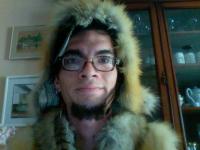


Osiyo. Our grandfathers’ most ancient stories tell us that we Cherokees were in exodus and walked a great distance when we came to the ocean. With faith we built rafts and crossed the ocean, coming from the East to the West and established a life for ourselves in this new land of the Americas. About 1000 B.C., a people from a rubber tree forest invaded Eastern Mexico. The indigenous Mexicans called these newcomers the Olmec. They were a people completely obsessed with magic; we avoided them by traveling to the North.
Many Mayan carvings suggest racial mixtures.
Our Cherokee traditional stories interlock and agree with several of the ancient pre-Columbian Mayan and Mexican legends which tell of a people arriving from the East who believed in a single, benevolent, providing God. Some of these travelers from the East had different coloration of eyes and skin shade; some had beards. The Maya and other early Mexicans drew pictures of these people, who wore hats and turbans not unlike those the Cherokee have always worn and wear today. The Mexican legends said that these people would return in time. (the bringing back of the old knowledge, way of life and teachings)
A Mayan carving showing man in a turban & beard with a non-Mayan nose.
It is not known to this day which people or combination of peoples built the great pyramid city of the Valley of Mexico, but the Cherokees were living in Mexico at that time, as were the Tlamatinimi (which means “wise men” in the ancient Mexican language). They were a pre-Columbian group of intellectuals, engineers, and astronomers who shared a common belief or connection with the Cherokee in that their religion also had only one God who was merciful, who had created all things, and who would provide what you needed, not necessarily what you wished. This ancient Mexican society, the Tlamatinimi, was supremely rational and civilized, arguably even more civilized than Greeks or Romans. Their society existed within different Mexican civilizations and were unfazed by the threat of a gallery of monster gods used to motivate and control the populace. In 1450 A.D. they were centered at Texcoco. Mayan carving showing Turban with blond mustache & freckled cheekbones supporting Mayan legends of a people who came from the East who worshipped but one God.
Cherokee migration legend tells of our exodus north, three to four thousand years ago, past the river of the ferocious ones, which we believe to be the Rio Grande River where the cannibalistic Karankawas lived. In the mid-1800’s, Stephen F. Austin saw this tribe in person and described them as very handsome and intimidating, with men averaging 7 ft. in height and women 6 ft.
The Cherokee pushed on to the big waters of the Mississippi, then on to the headwaters of the Ohio, where they built walled cities and huge mounds for burial. The Delaware came from the west and, with assistance from the Iroquois federation, fought to remove the Cherokee, for the time period of 7 chiefs, or approximately 200 years, before the Cherokee went East to the mountains and coast. The exodus was pressured by war to continue south with the Cherokees arriving in the Georgia area in approximately 800 to 1000 A.D.
The surviving Cherokees were arrested and faced with the captivity of the military reservation, but instead resisted and fled to the freedom of the Republic of Mexico. These refugee Cherokees asked the courageous Mexican leaders for help and were granted “amparo” or political amnesty. They were granted permission and settled in the Mexican states of Coahuila, Chihuahua, Nuevo Leon, and Tamaulipas, with the majority choosing to settle in mountainous Coahuila near the historic city of San Fernando now known as Zaragosa.